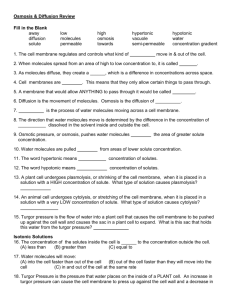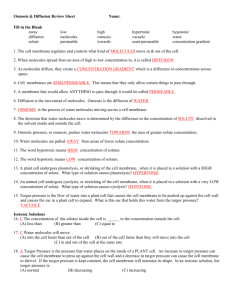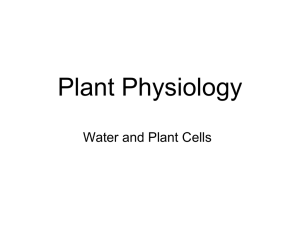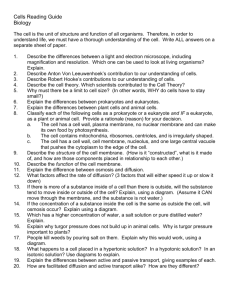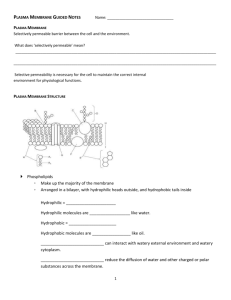osmosis_diffusion_review
advertisement
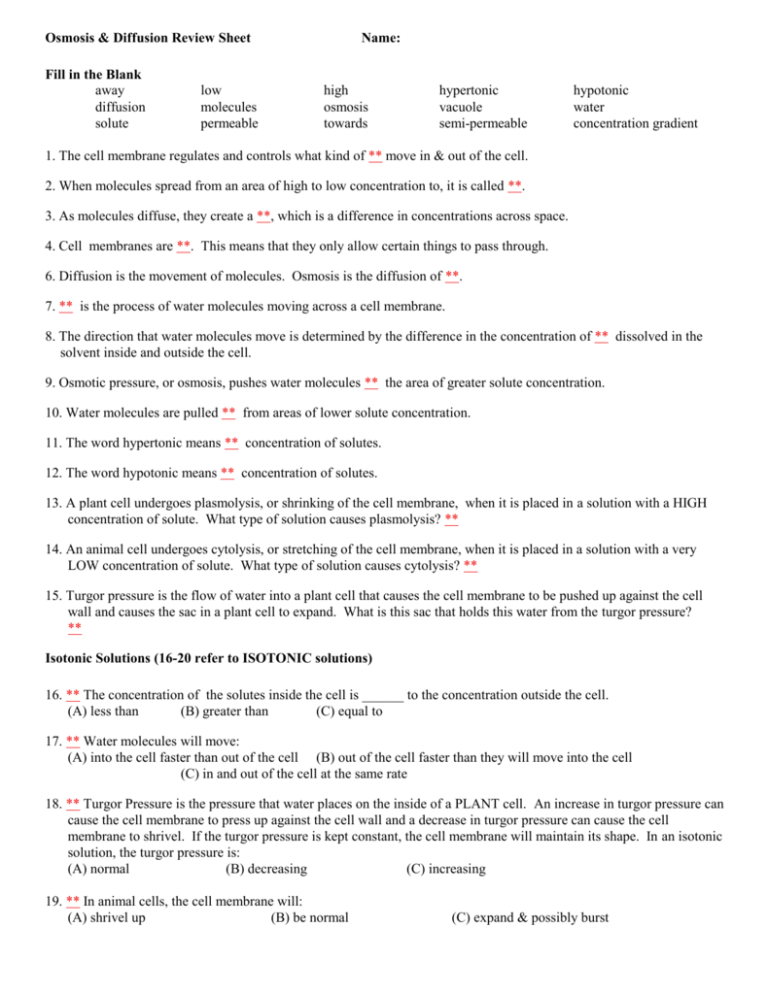
Osmosis & Diffusion Review Sheet Fill in the Blank away diffusion solute low molecules permeable Name: high osmosis towards hypertonic vacuole semi-permeable hypotonic water concentration gradient 1. The cell membrane regulates and controls what kind of ** move in & out of the cell. 2. When molecules spread from an area of high to low concentration to, it is called **. 3. As molecules diffuse, they create a **, which is a difference in concentrations across space. 4. Cell membranes are **. This means that they only allow certain things to pass through. 6. Diffusion is the movement of molecules. Osmosis is the diffusion of **. 7. ** is the process of water molecules moving across a cell membrane. 8. The direction that water molecules move is determined by the difference in the concentration of ** dissolved in the solvent inside and outside the cell. 9. Osmotic pressure, or osmosis, pushes water molecules ** the area of greater solute concentration. 10. Water molecules are pulled ** from areas of lower solute concentration. 11. The word hypertonic means ** concentration of solutes. 12. The word hypotonic means ** concentration of solutes. 13. A plant cell undergoes plasmolysis, or shrinking of the cell membrane, when it is placed in a solution with a HIGH concentration of solute. What type of solution causes plasmolysis? ** 14. An animal cell undergoes cytolysis, or stretching of the cell membrane, when it is placed in a solution with a very LOW concentration of solute. What type of solution causes cytolysis? ** 15. Turgor pressure is the flow of water into a plant cell that causes the cell membrane to be pushed up against the cell wall and causes the sac in a plant cell to expand. What is this sac that holds this water from the turgor pressure? ** Isotonic Solutions (16-20 refer to ISOTONIC solutions) 16. ** The concentration of the solutes inside the cell is ______ to the concentration outside the cell. (A) less than (B) greater than (C) equal to 17. ** Water molecules will move: (A) into the cell faster than out of the cell (B) out of the cell faster than they will move into the cell (C) in and out of the cell at the same rate 18. ** Turgor Pressure is the pressure that water places on the inside of a PLANT cell. An increase in turgor pressure can cause the cell membrane to press up against the cell wall and a decrease in turgor pressure can cause the cell membrane to shrivel. If the turgor pressure is kept constant, the cell membrane will maintain its shape. In an isotonic solution, the turgor pressure is: (A) normal (B) decreasing (C) increasing 19. ** In animal cells, the cell membrane will: (A) shrivel up (B) be normal (C) expand & possibly burst 20. ** In the picture to the right, the movement of water across the membrane will be (A) mostly out (B) mostly in (C) in and out equally 10% salt 10% salt Hypotonic Solutions: (21-25 refer to HYPO-TONIC solutions) 21. ** The concentration of the solutes inside the cell is________ to the concentration outside the cell. (A) less than (B) greater than (C) equal to 22. ** Water molecules will move: (A) into the cell faster than out of the cell (B) out of the cell faster than they will move into the cell (C) in and out of the cell at the same rate 23. ** Turgor Pressure is the pressure that water places on the inside of a PLANT cell. An increase in turgor pressure can cause the cell membrane to press up against the cell wall and a decrease in turgor pressure can cause the cell membrane to shrivel. If the turgor pressure is kept constant, the cell membrane will maintain its shape. In a hypotonic solution, the turgor pressure is: (A) normal (B) decreasing (C) increasing 24. ** In animal cells, the cell membrane will: (A) shrivel up (B) be normal (C) expand & possibly burst 25. ** In the picture to the right, the movement of water across the membrane will be (A) mostly out (B) mostly in (C) in and out equally 2% salt 10% salt Hypertonic Solutions (26-30 refer to HYPER-TONIC solutions) 26. ** The concentration of the solutes inside the cell is ________ to the concentration outside the cell. (A) less than (B) greater than (C) equal to 27. ** Water molecules will move: (A) into the cell faster than out of the cell (B) out of the cell faster than they will move into the cell (C) in and out of the cell at the same rate 28. ** Turgor Pressure is the pressure that water places on the inside of a PLANT cell. An increase in turgor pressure can cause the cell membrane to press up against the cell wall and a decrease in turgor pressure can cause the cell membrane to shrivel. If the turgor pressure is kept constant, the cell membrane will maintain its shape. In a hypertonic solution, the turgor pressure is: (A) normal (B) decreasing (C) increasing 29. ** In animal cells, the cell membrane will: (A) shrivel up (B) be normal (C) expand & possibly burst 30. ** In the picture to the right, the movement of water across the membrane will be (A) mostly out (B) mostly in (C) in and out equally 30% salt 10% salt ACTIVE vs. PASSIVE TRANSPORT: endocytosis, exocytosis, facilitated, simple, active, passive, protein, 31. When a cell goes against the concentration gradient to move material inside this is know as _**__ transport. 32. When a cell uses a ___**__ channel in order to get large molecules across the cell membrane this is known as ___**___ diffusion. 33. When your brain cells release a large amount of dopomine at one time, it uses the bulk transport __**___ 34. When your white blood cell “swollows” a virus, this is an example of _**__.
